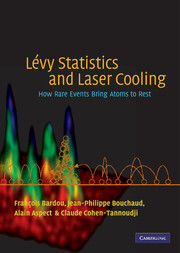Book contents
- Frontmatter
- Contents
- Foreword
- Acknowledgements
- 1 Introduction
- 2 Subrecoil laser cooling and anomalous random walks
- 3 Trapping and recycling. Statistical properties
- 4 Broad distributions and Lévy statistics: a brief overview
- 5 The proportion of atoms trapped in quasi-dark states
- 6 The momentum distribution
- 7 Physical discussion
- 8 Tests of the statistical approach
- 9 Example of application: optimization of the peak of cooled atoms
- 10 Conclusion
- Appendix A Correspondence between parameters of the statistical models and atomic and laser parameters
- Appendix B The Doppler case
- Appendix C The special case µ = 1
- References
- Index of main notation
- Index
9 - Example of application: optimization of the peak of cooled atoms
Published online by Cambridge University Press: 06 July 2010
- Frontmatter
- Contents
- Foreword
- Acknowledgements
- 1 Introduction
- 2 Subrecoil laser cooling and anomalous random walks
- 3 Trapping and recycling. Statistical properties
- 4 Broad distributions and Lévy statistics: a brief overview
- 5 The proportion of atoms trapped in quasi-dark states
- 6 The momentum distribution
- 7 Physical discussion
- 8 Tests of the statistical approach
- 9 Example of application: optimization of the peak of cooled atoms
- 10 Conclusion
- Appendix A Correspondence between parameters of the statistical models and atomic and laser parameters
- Appendix B The Doppler case
- Appendix C The special case µ = 1
- References
- Index of main notation
- Index
Summary
Introduction
The statistical approach presented in this book provides not only a deeper physical understanding of subrecoil cooling, but also analytical expressions for the various characteristics of the momentum distribution of the cooled atoms. A great confidence in the validity of these predictions has been obtained in the previous chapter, by comparing them with experimental and numerical results. Therefore, we are now entitled to apply the approach developed in this work to specific problems, such as the optimization of one particular feature of the cooling process, namely the height of the peak of cooled atoms. This is the subject of this chapter.
Finding empirically the optimum conditions for a subrecoil cooling experiment is a difficult task. There are a priori many parameters to be explored and each experiment with a given set of parameters is in itself lengthy. The same can also be said of numerical simulations. One needs guidelines such as those provided by the present statistical approach to reduce the size of the parameter space to be explored.
There is a variety of optimization problems that can be considered. Following usual motivations of laser cooling, like the increase of atomic beam brightness or the search for quantum degeneracy, we will concentrate here on optimizing the height h(θ) of the peak of the momentum distribution of the cooled atoms, which corresponds also to the gain in phase space provided by the cooling (see Section 6.2.3).
- Type
- Chapter
- Information
- Lévy Statistics and Laser CoolingHow Rare Events Bring Atoms to Rest, pp. 124 - 136Publisher: Cambridge University PressPrint publication year: 2001

